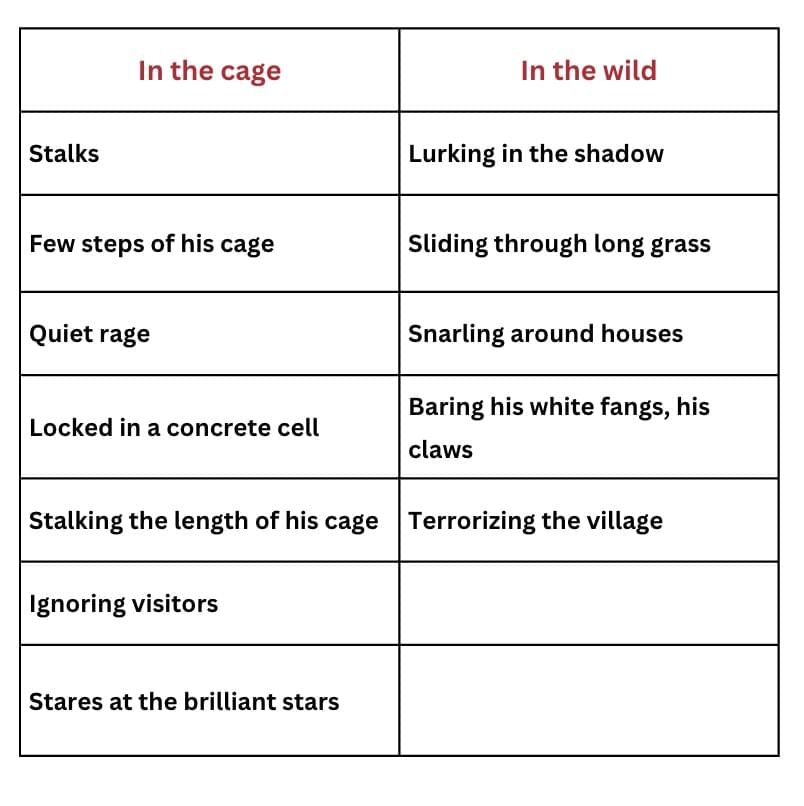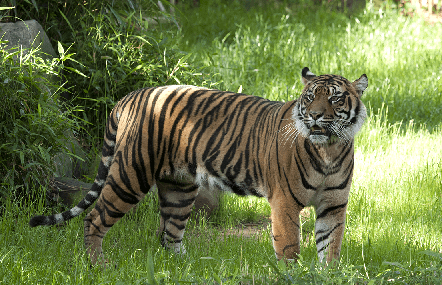NCERT Solutions for Class 10 English First Flight Chapter 3 - A Tiger in the Zoo
Q1. Read the poem again, and work in pairs or groups to do the following tasks.
(i) Find the words that describe the movements and actions of the tiger in the case and in the wild. Arrange them in two columns.
(ii) Find the words that describe the two places, and arrange them in two columns.
Now try to share ideas about how the poet uses words and images to contrast the two situations.
Ans:
(i)
(ii) 
Q2. Notice the use of a word repeated in lines such as these:
(i) On pads of velvet quiet,
In his quiet rage.
(ii) And stares with his brilliant eyes
At the brilliant stars.
What do you think is the effect of this repetition?
Ans: The poet uses repetition to create a poetic effect, highlighting the tiger’s growing anger and silent helplessness while trapped in his concrete cage. The phrase "velvet quiet" refers to the tiger's soft paws, which are quiet and unable to run or leap. The tiger can only pace within the small space of his cage. "Quiet rage" represents the tiger’s inner anger and wild nature, which is building up as he longs to run freely in the forest and hunt. His rage remains quiet because he is locked in the cage and powerless. The repetition of "quiet" adds a musical quality to the poem. Likewise, using the word "brilliant" for both the tiger’s eyes and the stars emphasizes the majestic nature of both. The tiger looks at the brilliant stars with his brilliant eyes, dreaming of the free and beautiful life he could have had in the forest. This repetition gives the poem a rhythmic flow and a sense of grandeur.
 Tiger
Tiger
Q3. Read the following two poems − one about a tiger and the other about a panther. Then discuss:
Are zoos necessary for the protection or conservation of some species of animals? Are they useful for educating the public? Are there alternatives to zoos?
The Tiger
The tiger behind the bars of his cage growls,
The tiger behind the bars of his cage snarls,
The tiger behind the bars of his cage roars.
Then he thinks.
It would be nice not to be behind bars all
The time
Because they spoil my view
I wish I were wild, not on show.
But if I were wild, hunters might shoot me,
But if I were wild, food might poison me,
But if I were wild, water might drown me.
Then he stops thinking
And...
The tiger behind the bars of his cage growls,
The tiger behind the bars of his cage snarls,
The tiger behind the bars of his cage roars.
-- By Peter Niblett
The Panther
His vision, from the constantly passing bars,
has grown so weary that it cannot hold
anything else. It seems to him there are
a thousand bars; and behind the bars, no world.
As he paces in cramped circles, over and over,
the movement of his powerful soft strides
is like a ritual dance around a centre
in which a mighty will stands paralysed.
Only at times, the curtain of the pupils
lifts, quietly. An image enters in,
rushes down through the tensed, arrested muscles,
plunges into the heart and is gone.
--By Rainer Maria Rilke
Ans: A zoo is a place where various species of animals, including some that are endangered or on the brink of extinction, are housed and cared for. These animals, such as tigers, lions, and other vulnerable species, often face significant threats in the wild due to poaching for illegal trade, habitat destruction, and human encroachment. Zoos play a crucial role in the conservation and protection of these species by offering a controlled and secure environment where they can be safeguarded from such dangers.
Beyond mere protection, zoos also serve an educational purpose by raising awareness among the public about the importance of wildlife and its essential role in maintaining the ecological balance of our environment. Visitors can learn about the behaviors, habitats, and threats faced by these animals, helping foster a deeper appreciation for their conservation.
However, while zoos provide a safe space for endangered animals, other alternatives such as wildlife sanctuaries, forest reserves, and national parks offer a more natural setting. These places not only protect and conserve the species but also allow animals to live in their natural habitat with minimal human interference. These alternatives are vital for long-term conservation efforts, ensuring that animals can thrive in the wild while being shielded from poaching and habitat loss.
|
61 videos|620 docs|69 tests
|
FAQs on NCERT Solutions for Class 10 English First Flight Chapter 3 - A Tiger in the Zoo
| 1. What is the main theme of the poem "A Tiger in the Zoo"? |  |
| 2. How does the poet describe the tiger's behavior in the zoo? |  |
| 3. What literary devices are used in "A Tiger in the Zoo"? |  |
| 4. How does the poem reflect the idea of captivity and its impact on animals? |  |
| 5. What message does the poet convey about wildlife conservation in "A Tiger in the Zoo"? |  |

















